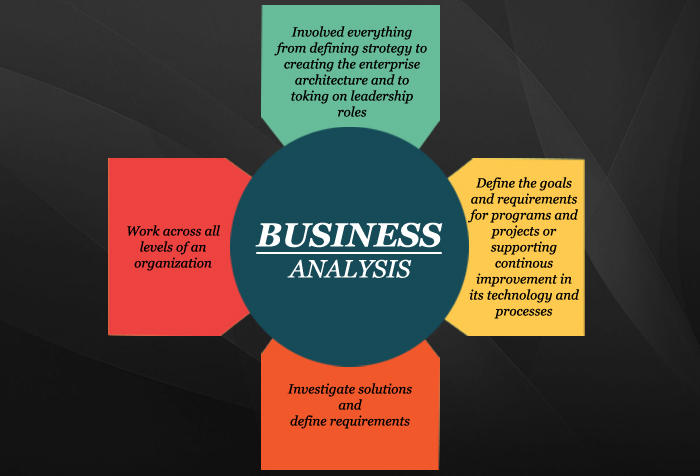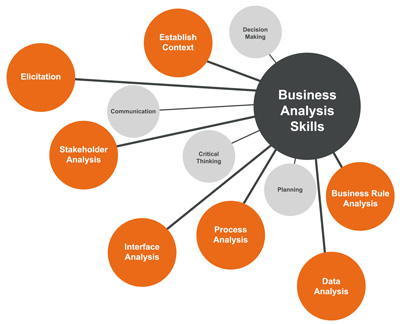6 Tips: Business Analysis
Every software project is unique and there’s no guarantee that the approach or strategy that works well for one project will work for another. There are however, some basic guidelines business analysts can adopt to add value to software projects : moPharma

Tips: Business Analysis
Most software development or mobile app development problems are based on two fundamental issues:
Trying to solve the wrong problem; what we think is the problem is not always so.
The solution to the real problem is often
Universal tips every analyst should remember:
Evolve Requirements
Do not expect to get all your requirements from users. Users will never be able to define 100% what they want. Adopt an iterative process that will allow requirements to be fine-tuned as the software devlopment project goes on. Early prototyping and constant feedback from users during the software development project can help clarify requirements and guide the software development process.
Don’t Impose Change
Work within the environment and take the reality of the organization into consideration. Users should be the ones deciding what degree of change they are willing to accept. As an analyst, you may come up with an idea that you believe represents the right course of action; stakeholders should however, be the ones to decide which course of action they are ready to take. To achieve this, adopt a realistic approach that does not mandate a drastic cultural change in the environment. This will reduce or eliminate any resistance down the line.
Assess Stakeholders
In addition to conducting stakeholder analysis, know the skill sets of users before engaging with them. This would allow you to set up a plan for approaching each user category and defining the kind of questions to direct at them. Understanding the technical capabilities of users guides the analyst on how to phrase interview questions and identify who else, in addition to the identified stakeholder, may be required at the interview. This is where a pre-meeting comes in - this is a short meeting for gauging the stakeholder's technical competence and level of interest in the project before the main working sessions are organized.
Don’t Ignore the Politics
Assume that every situation is political. Software development projects are not complex on their own; it’s people that make them so. Don’t ignore the political environment or the constraints it imposes. To do so is to invite failure. A key question to ask stakeholders is this: “Can you give me some perspective on potential departmental or personnel conflicts that may occur during this project?”. You may not get all the information you need at once from one person, but the feedback you get over time, is bound to improve your knowledge of any existing politics.
Pilot Before Rollout
Always set up a pilot environment. This will provide useful feedback on both the effectiveness and shortcomings of the delivered software development product, which can be addressed before full implementation.
Plan Realistically
Ensure that your project plan is realistic. Always make allowance for iterations between analysis, software development/mobile app development/configuration and testing. The back and forth between analysis, development and testing is inevitable and should be captured in your plan realistically. This will ensure that resources are available when needed and that everyone believes in the practicality of the project plan.
Be Resourceful:
Business analysts know where to find the right answers to certain problems, and also know that answer won’t just come to them. They find alternative paths through the organization and involve the right people at the right time. A good analyst rarely gets stopped for long and can often work through challenging situations to come through to a solution.
Have the Basics Covered:
A good business analyst has a good, strong foundation under their belt. They comprehend the basics first and foremost. Good analysts are good communicators, problem-solvers, and they also think critically. They create requirement specifications, analyze requirements, create visual models, facilitate elicitation sessions, and use the necessary tools. These tools and more are examples of the basics of good analysts.
Constantly Grow Your Skills:
Good analysts are not content to do the same things in the exact same way every time. Gaining confidence to apply a wide variety of business analysis techniques will increase any individual’s marketability and thus make any analyst more efficient. Good business analysts know how to pick the right tool for the job instead of relying on just basic tools and applying them to every situation.
Have a Strong Sense of Project Management:
Business analysts are proactive and dependency aware. They manage themselves to commitments and deadlines. A business analyst also get stakeholders involved at the right times and in the right ways and works hard to keep everything moving. They keep a close eye on value and feasibility and guide their stakeholders toward a set of requirements that can actually get implemented.
Don’t Rely on Cookies:
Although stakeholders and developers like cookies, and it always feels good to be appreciated for hard work, good analysts don’t rely on bribes to sustain positive relationships. A good business analyst will use active listening techniques to ensure stakeholders feel that their needs and desires are being listened to. They consistently follow through on their commitments, and don’t make promises they can’t keep. They honor confidentiality agreements and are generally seen as above office gossip. In the end, quality business analysts are professional and align their skills and actions for sustained project success.
Tips For Success As A New Lead Business Analyst
It is more than likely someone recognizes the good work that you have done in the past and their hope is that your prior success can be replicated with multiple Business Analysts on this new initiative. Like any new experience, you may have some anxiety regarding this new role. It is important to you that what happens will turn out to be a future success story and not an experience that stays in the closet.
Here are some tips for success as a new lead Business Analyst from someone who has gone through the experience. I have also had the opportunity to observe many colleagues who have succeeded in this role and some who have crashed and burned.
1. Understand the Role
Spend time upfront figuring out the role of the lead Business Analyst in the context of the work effort that you are about to join.
Do not make assumptions on expected tasks or deliverables. While the function is becoming more common, there is no universally accepted definition for the lead Business Analyst role. Some experts view the lead Business Analyst as a formal role inheriting many project management-type responsibilities while others view the lead Business Analyst as an informal way of steering people in a common direction. There is no consensus.
Work with the manager who assigned you to this role (Project Manager or Business Analyst Manager) to understand their expectations and their interpretation of the role. Ask the question “What is your definition of success for this role?”
Provide input about your views on how you can provide value as the lead.
Capture the outcome of the dialogue to provide a reference point that you can subsequently use to ensure you are on track.
What I have observed in practice is that many people accept the lead BA role on a project and skip this step because they feel they are a natural leader, that they inherently understand what is needed, or that the expectations (in their mind) are obvious. They subsequently bump into reality when results do not happen the way they or their manager expected. Combat this possibility by understanding the role upfront.
2. Set Team Expectations Upfront
Spend time upfront with assigned Business Analysis resources on the team to reach a common understanding of roles and responsibilities. Recognize that Business Analysts have an independent streak and often are used to steering their own ship.
Avoid describing a responsibility with the words “participate” or “contribute”; such ambiguity invariably leads to future conversations.
Recognize that team members have different experiences and viewpoints on what tasks and deliverables are necessary to be successful. This is a dialogue, not a monolog.
Capture the shared understanding of a team discussion to provide a reference point for keeping the team in harmony going forward.
Setting team expectations of the relative role of different members of the team is a practice that seems to be very much in its infancy from an adoption perspective. On the positive side, the practice of using Business Analysis plans on large projects seems to be growing, which lends itself to this task.
3. Communicate Openly and Transparently
Take guidance from our Agile brethren by communicating openly and transparently. There is no mystery here; good leaders are good communicators. Motivate and inspire people through clear communication. Build trust through direct and open communication; do not be afraid to share difficult messages. Do not be afraid of the difficult conversation.
Do not treat information as currency, to be controlled and dispensed as it fits your needs. Banish the phrase “need to know.”
Communicate information from top to bottom as well as bottom to top. Communication should be continuous; err on the side of over-communicating; people do not always hear, understand or make a connection when they receive a message the first time.
Remember your actions communicate a message. The message that you communicate verbally and the actions you follow should be in accord.
If you fail to communicate properly, you can poison the atmosphere between you and your colleagues, as well as the morale of the project team. Communication is paramount to your success as a new lead Business Analyst.
4. Lead by Example
Show what you expect by taking the lead by example approach. Taking the role of a lead Business Analyst should not preclude being an active participant in the project.
Make it easier for people to follow you by piloting the approach for Business Analysis that was agreed upon during upfront planning.
Set the standard for excellence with your actions; be the role model and do not dabble in mediocrity.
Build trust by sharing your experiences and how you adjust from the initial gameplan.
Do not be afraid to ask for help; illustrate that no one has all the answers and that we rely on each other for success.
In my experience, successful lead Business Analysts are the ones that engage directly and share in the accountability for the deliverables. The lead Business Analyst who is preoccupied with status reports and attending management meetings is often viewed as too remote to understand the real issues being faced by the Business Analyst in the trenches.
5. Accept When You Are Wrong
Accept that as a lead Business Analyst you will not be perfect. You will not get everything right at first and will make mistakes along the way. Your success on this project is dependent on how you handle mistakes and failures.
Openly acknowledge mistakes in leadership that impact the team and the outcome of the project. Take ownership of the mistake(s).
Keep calm; handle failures with grace and humility. Move forward by reflecting on the challenge and identifying lessons learned. A significant component of leadership is related to your ability to influence. Accepting when you are wrong illustrates your humanity and builds trust within the team.
6. Know When to Keep Silent
As a new leader, avoid the temptation to micromanage contributors on the team. Know when to keep silent. Setting guidelines by communicating the expected outcome is acceptable. Paying excessive attention to how a resource does their job is counterproductive and leads to conflict.
Treat Business Analysts as professionals and give them the benefit of the doubt when you contemplate stepping in to provide direction.
Do not undermine the authority and credibility of a Business Analyst during elicitation sessions by intervening to steer the outcome into what you expect. Use the offline time to guide, coach, and mentor resources.
Talk to your team about how they want you to provide direction and how you would like to be kept apprised of their progress.
Do not overreact when things do not go the way you expected. Instead, reflect on whether your expectations were realistic and how your guidance could be improved.
Remember that individuals will feel disempowered and not trusted to fully complete their work when they encounter excessive involvement by their supervisor or leader.
Knowing when to keep silent and when to intervene is not always straightforward for the new lead Business Analyst. If in doubt, reflect on your desire for control, weighing it against the need to develop and grow the team.
7. Apply Servant Leadership
View your role on the project through the lens of a servant leader. Put your team first and yourself second.
Listen first and practice empathy. Acknowledge the perspectives of others before asserting your viewpoint.
Understand the obstacles faced by the Business Analysts when facing their deadlines.
Distinguish between obstacles they can solve on their own and the ones that need assistance. Provide the support needed by removing those obstacles.
Use persuasion and influence to set direction; resist the temptation to dictate the process.
Champion the success of the contributors; act as a cheerleader by applauding victories and witnessing people doing good things.
Look beyond the delivery of documents as a measurement of success. Look at the professional growth of your team members as an equal victory.
Applying servant leadership is more than knowing when to keep silent and avoiding micromanagement. It means being vocal and active while serving the needs of the team.
In Conclusion
No matter your background, age, or experience, we all share something in common: a desire to be successful. As noted in the beginning, being lead on a team of Business Analysts for the first time can cause some people anxiety. Following the seven tips listed represents an effective start towards addressing the fears and meeting the goal, the outcome of success. These tips are based on the patterns that I have observed in my career as an experienced Business Analyst. However, they are certainly not conclusive. What has your experience been? What advice would you provide? Cheers to your success and future learnings.
If you are looking to build your next (or first) mobile app and need help with one or more of these steps, you’re in luck! The moPharma Group welcomes app owners at any stage in this process. Whether you are a startup or Fortune 50 company, we have the team and knowledge needed to deliver a fantastic mobile app. Please don’t hesitate to write us today.





Discuss about post